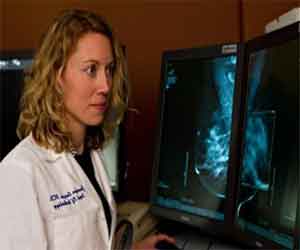- Home
- Editorial
- News
- Practice Guidelines
- Anesthesiology Guidelines
- Cancer Guidelines
- Cardiac Sciences Guidelines
- Critical Care Guidelines
- Dentistry Guidelines
- Dermatology Guidelines
- Diabetes and Endo Guidelines
- Diagnostics Guidelines
- ENT Guidelines
- Featured Practice Guidelines
- Gastroenterology Guidelines
- Geriatrics Guidelines
- Medicine Guidelines
- Nephrology Guidelines
- Neurosciences Guidelines
- Obs and Gynae Guidelines
- Ophthalmology Guidelines
- Orthopaedics Guidelines
- Paediatrics Guidelines
- Psychiatry Guidelines
- Pulmonology Guidelines
- Radiology Guidelines
- Surgery Guidelines
- Urology Guidelines
3D mammography improves screening accuracy in breast cancer

3D mammography improves screening accuracy in breast cancer, even in patients with dense breasts.UC Davis researchers have in the first-of-its-kind study found that new technology helpful for women regardless of breast density.
Diana Miglioretti and colleagues found that radiologists who interpret traditional mammograms, which are two-dimensional, required little startup time for transitioning to reading digital breast tomosynthesis (DBT), or 3D mammography, with improved screening accuracy. The study has been published in Radiology.
"We found that patients with or without dense breasts benefit from lower recall rates with 3D mammography and there is no trade-off with cancer detection," said Miglioretti, dean's professor of biostatistics in the UC Davis Department of Public Health Sciences. "In fact, we were surprised to find that improvements in recall rates were larger in women without dense breasts."
The researchers found that radiologists recalled patients for additional testing at a lower rate on 3D mammography than they did on 2D mammography, without sacrificing cancer detection. A patient may be recalled if there is a suspicious finding on the screening examination that requires follow-up imaging and possibly biopsies to determine if it is cancer. Three-dimensional views are taken as part of a DBT screening help the radiologist confirms that some findings on 2D images are not cancer and so fewer patients have to be recalled. These improvements were seen regardless of the patient's breast density.
The study included data from 104 radiologists from 53 facilities in five U.S. states, collected by the Breast Cancer Surveillance Consortium (BCSC) to evaluate whether radiologists experience a learning curve for 3D mammography interpretive performance. The study is the largest of its kind and represented a broad range of radiology centres and providers. It is novel because it tracked radiologists' performance over time as they transitioned from digital mammography to DBT.
DBT takes multiple X-ray images of each breast from many angles which are then computer assembled into a three-dimensional image of the breast that the radiologist can scroll through. The U.S. Food and Drug Administration requires only eight hours of additional training for qualified radiologists to be able to interpret DBT studies. Researchers wondered if there was a learning curve associated with the interpretive performance of this new technology and if any improvements are sustained by radiologists over time.
"We found both breast imaging subspecialists and general radiologists improved their screening performance when they switched from 2D to 3D mammography," said Miglioretti. "These improvements were sustained for at least two years after the adoption of the new technology."
Most women in the U.S. do not have their mammograms interpreted by a breast imaging subspecialist, nor do they have access to academic medical centres. The study evaluated radiologists with a mix of experience at both academic and non-academic facilities. Both breast imaging subspecialists and general radiologists improved their interpretive performance quickly after adopting DBT, with lower recall rates and similar cancer detection rates as for digital mammography.
"Women who want to reduce their chances of being recalled for additional testing may want to ask for digital breast tomosynthesis at their next screening exam," said Miglioretti.

Disclaimer: This site is primarily intended for healthcare professionals. Any content/information on this website does not replace the advice of medical and/or health professionals and should not be construed as medical/diagnostic advice/endorsement or prescription. Use of this site is subject to our terms of use, privacy policy, advertisement policy. © 2020 Minerva Medical Treatment Pvt Ltd